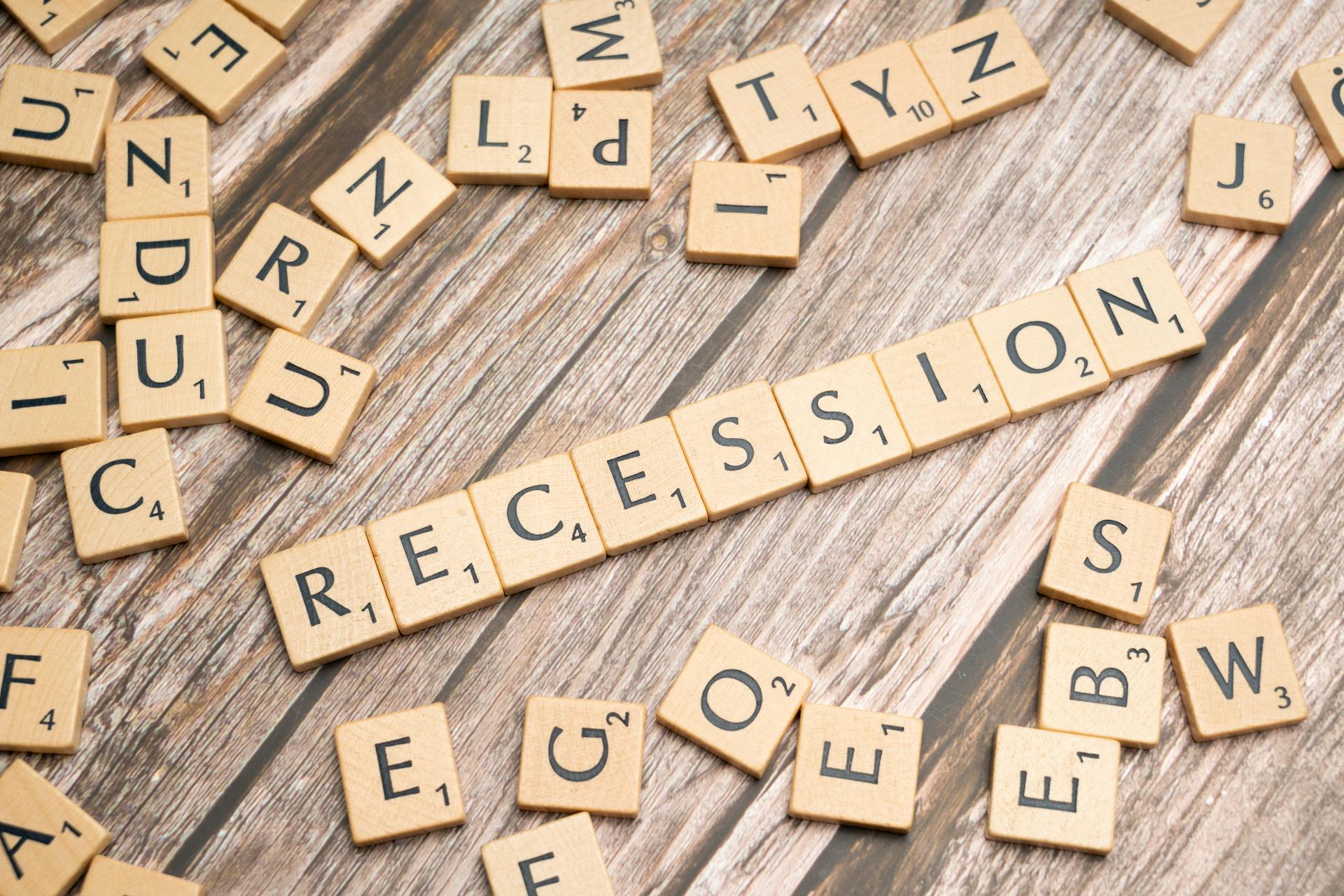
Economic risk is a significant concern for investors and businesses operating in global markets. The impact of economic risk can be devastating, as seen in the example of the 2008 global financial crisis, which resulted in trillions of dollars in losses.
A key aspect of economic risk is currency risk, which can significantly impact a company's bottom line. For instance, a company that exports goods to other countries may face a significant loss if the value of its local currency depreciates.
Companies can mitigate currency risk by hedging their bets through various financial instruments, such as forward contracts and options. This can help protect against unexpected currency fluctuations.
Economic risk can also be influenced by factors such as inflation, interest rates, and government policies.
On a similar theme: The Global Risk Report 2024
Types of Economic Risks
Economic risk is a complex and multifaceted concept that can be broken down into several key types. One of the most critical types of economic risk is Sovereign Risk, which refers to the risk that a government will default on its debt and negatively impact businesses operating in the country.
You might like: What Are the Types of Risk in Insurance
Sovereign Risk is a significant concern because it can trigger other troubles related to the business, such as changes in government policies that affect the exchange rate and business transactions. This type of risk is not limited to a government defaulting but also includes political unrest and changes in policies made by the government.
There are several other types of economic risk, including Credit Risk, which refers to the risk that a counterparty will default on making payments. This type of risk is entirely out of control because it depends on another entity's worthiness to pay its debts. Credit Risk can be mitigated by monitoring a counterparty's business activities on a timely basis.
Another type of economic risk is Exchange Rate Risk, which refers to the risk of a significant movement in the exchange rate. This can have a direct impact on businesses operating in international markets, making it essential to understand and manage this type of risk.
Here are some of the key types of economic risk:
- Sovereign Risk: the risk that a government will default on its debt.
- Credit Risk: the risk that a counterparty will default on making payments.
- Exchange Rate Risk: the risk of a significant movement in the exchange rate.
- Economic Risk: the risk exposure of an investment made in a foreign country due to changes in business conditions or adverse effects of macroeconomic factors.
Emerging and Developing Economies
Emerging and developing economies face significant challenges in the 21st century, with global growth expected to hold steady at 2.7 percent in 2025-26, a rate that's insufficient to foster sustained economic development.
The global economy is settling at a low growth rate, which will make it difficult for emerging market and developing economies to catch up with advanced economies. Most low-income countries are not on course to graduate to middle-income status by 2050.
Developing economies are facing fierce headwinds, including weak investment and productivity growth, aging populations in many of the poorest countries, rising geopolitical tensions, and the mounting dangers of climate change.
A fresh game plan is needed to strengthen the capacity of developing economies to fend for themselves and seize growth opportunities. The next 25 years will be a tougher slog than the last 25, according to World Bank Group Chief Economist and Senior Vice President Indermit Gill.
Here are some key statistics highlighting the challenges faced by emerging and developing economies:
- Global growth rate: 2.7 percent in 2025-26
- Per capita incomes: on a trajectory that implies feeble catch-up toward those of advanced economies
- Low-income countries: not on course to graduate to middle-income status by 2050
Exposures to Rewarded Factors
Economic risks can arise from various factors, including recessions, inflation, exchange rate fluctuations, political instability, trade disputes, regulatory changes, and natural disasters. Managing economic risk involves assessing and understanding the potential impacts of these factors on financial performance.
Investors require compensation for additional risks brought by factor exposures in bad times. For instance, building a value factor sleeve of a multi-factor index involves selecting stocks with the highest book-to-market ratio adjusted for unrecorded intangibles.
To assemble a multi-factor portfolio, it's essential to design single-factor sleeves with strong exposure to their desired factor but without negative exposures to other rewarded factors. This approach enables us to build multi-factor portfolios with strong and well-balanced exposure to all rewarded factors.
Here are the six consensus rewarded factors that emerge from academic literature and have passed sufficient hurdles to be considered robust:
- Size
- Value
- Momentum
- Volatility
- Profitability
- Investment
These factors have a long-term reward justified by economic rationale and are essential in designing a multi-factor portfolio that balances exposure to various factors.
Analyzing Economic Risks
Analyzing Economic Risks is a crucial aspect of understanding the complexities of the economy. The Economic and Political Risk Evaluator covers 11 risk variables, and we'll focus on the economic-related risks.
Sovereign risk is a major concern, as it involves the risk that a government will default on its debt. This can have a ripple effect on the entire economy.
The exchange rate risk is another significant factor, as it relates to the risk of a significant movement in the exchange rate. This can impact international trade and investment.
Trade credit risk is also a vital consideration, as it involves the risk that a trading partner will not pay its obligation. This can lead to financial losses for businesses.
Here are the economic risk variables:
- Sovereign risk: the risk that a government will default on its debt.
- Exchange rate risk: the risk of a significant movement in the exchange rate.
- Trade credit: the risk that a trading partner will not pay its obligation.
Business environment risks relate to the influence of societal and structural factors on business activity, including state and non-state actions. This can impact operating costs and market demand.
Intriguing read: Is Consulting a High Risk Business
Operating cost risk involves the risk that operating costs rise faster than recent trends. This can squeeze profit margins and impact business sustainability.
Market demand risk involves the risk that market demand could be significantly different to recent trends. This can impact business revenue and growth.
These economic risks can have far-reaching consequences for businesses and economies.
You might like: Pension Risk Transfer Market
Measuring Financial Conditions
Financial conditions can be tricky to measure, but one way to do it is by looking at the Federal Funds Rate (FCI-G). This gauge of financial conditions has swung significantly over the past two and a half years, moving from very accommodative levels in late 2021 to providing a drag on economic activity in 2022 and 2023.
The FCI-G has eased moderately since early this year, with monetary policy communications signaling that the federal funds rate had likely reached its peak for this tightening cycle. This has led to a decrease in downside risks to employment growth and a shift in the predictive distribution of inflation, with the modal forecast now centered around 2 percent.
Here's an interesting read: Hedging in Foreign Exchange Market
According to a statistical model, current financial conditions stand near the top of the range of values that are compatible with the empirical distribution of GDP growth observed in the United States in periods of economic expansion. This suggests that financial conditions are tight relative to their historical distribution, and may signal recession risks over the year ahead.
Related Services
If you're looking to stay ahead of the game in measuring financial conditions, you'll want to explore our related services. We offer a rigorous and transparent framework to measure the risk of a sharp currency depreciation.
Our Global Risk Service is a valuable tool for managing and mitigating risks. This service measures and forecasts the vulnerability of 166 countries to a sovereign crisis or a sovereign distress.
To better understand the potential impact of macro events, we recommend monitoring them closely. This can be done through our Economic and Political Risk Evaluator Brochure.
Here are some of our related services that can help you navigate the complexities of measuring financial conditions:
- Managing and mitigating risks
- Global Risk Service
- Economic and Political Risk Evaluator Brochure
Measuring Financial Conditions
Financial conditions have a significant impact on the economy, and understanding them is crucial for making informed decisions. Financial conditions can swing considerably over time, as seen in the past two and a half years.
The Federal Reserve's gauge of financial conditions, or FCI-G, measures the level of financial conditions. It has moved from very accommodative levels in late 2021 to providing a significant drag on economic activity in 2022 and 2023. Since early this year, it has eased moderately.
A statistical model maps financial conditions to the year-ahead distribution of GDP growth. This model identifies levels of financial conditions that predict GDP growth distributions that are consistent with either recessionary or non-recessionary outcomes.
Financial conditions currently stand near the top of the range of values that are compatible with the empirical distribution of GDP growth observed in the United States in periods of economic expansion. This suggests that the current level of financial conditions is relatively tight.
Related reading: What Is Economic Growth
The analysis suggests that downside risks to employment growth are estimated to be lower than those predicted at the end of 2023, when financial conditions peaked. The conditional distribution of inflation has shifted uniformly to the left, with the modal forecast centered approximately around 2 percent.
Here are the key indicators of financial conditions:
- FCI-G: The Federal Reserve's gauge of financial conditions.
- GDP growth distributions: The model maps financial conditions to the year-ahead distribution of GDP growth.
- Recessionary and non-recessionary outcomes: The model identifies levels of financial conditions that predict GDP growth distributions that are consistent with either recessionary or non-recessionary outcomes.
Impact of Economic Risks
Economic risks can have a significant impact on individuals and organizations. According to a study, 75% of businesses that experience a major economic downturn fail within a year.
Losing a significant portion of your income can be devastating, making it difficult to pay bills and cover living expenses. In fact, a survey found that 60% of people would struggle to pay their rent or mortgage if they lost their job.
Economic risks can also lead to reduced consumer spending, which can have a ripple effect throughout the economy. For example, a decline in consumer spending can lead to reduced sales for businesses, which can then lead to layoffs and further economic instability.
You might enjoy: Consumer Credit Risk Management
In times of economic uncertainty, it's essential to have a solid emergency fund in place to cover 3-6 months of living expenses. This can provide a safety net and help you weather financial storms.
Businesses that are not prepared for economic risks can struggle to stay afloat. A survey found that 40% of small businesses do not have a plan in place to address economic downturns.
Examples and Case Studies
Economic risk can have severe consequences, as seen in the case of Invexstar Capital Management in 2016. The company's sole trader refused to make payments for loss-making transactions, causing a chain reaction of losses for market-making banks, totaling £120 million.
Rogue trading can lead to regulatory repercussions and even result in traders being sacked for poor KYC checks. This highlights the importance of proper risk management and due diligence.
The impact of counterparty default can be catastrophic, potentially leading to a market collapse and stricter trade laws. This can have far-reaching consequences for the entire market.
In extreme cases, economic risk can result in significant financial losses, as seen in the example of Invexstar Capital Management.
Additional reading: Equity Market Risk
Sources
- https://www.worldbank.org/en/publication/global-economic-prospects
- https://www.oxfordeconomics.com/service/subscription-services/macro/economic-and-political-risk-evaluator/
- https://www.wallstreetmojo.com/economic-risk/
- https://www.federalreserve.gov/econres/notes/feds-notes/financial-conditions-and-risks-to-the-economic-outlook-20240920.html
- https://blogs.cfainstitute.org/investor/2024/08/19/mitigating-economic-risk-in-multi-factor-strategies/
Featured Images: pexels.com


